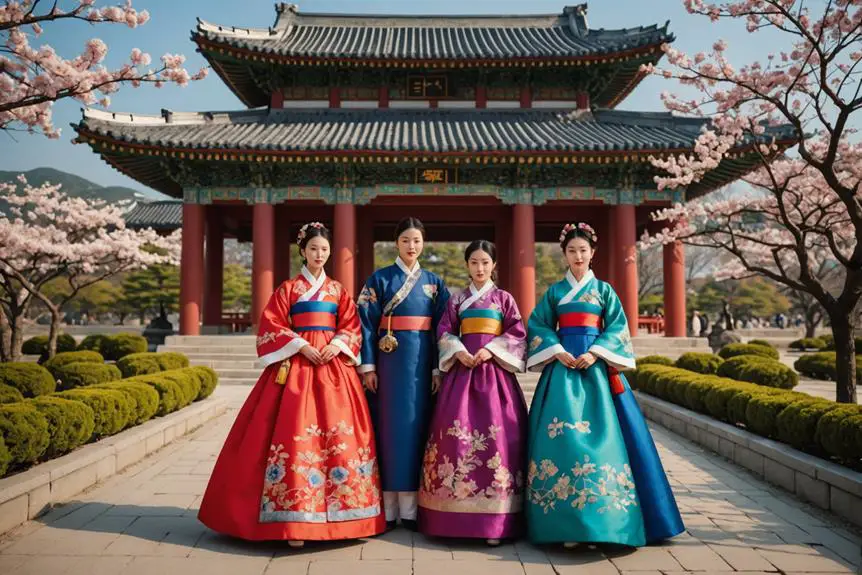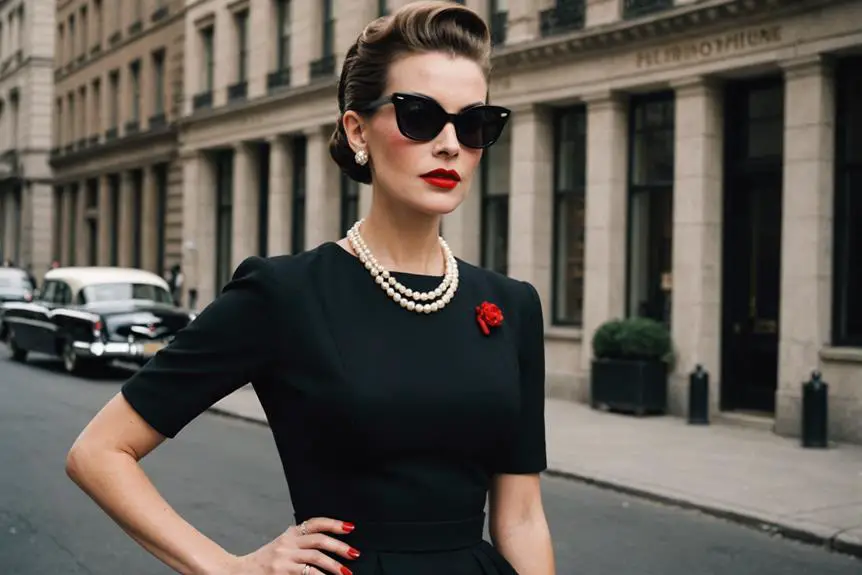When you examine the outfits in *The Handmaiden*, you'll notice how they're not just clothing but essential elements that reveal character depth and emotional transformation. Hideko's shift from soft pastels to vibrant hues mirrors her journey toward self-discovery, while Sook-hee's practical attire reflects her resilience and cunning. This interplay between fashion and narrative raises intriguing questions about cultural identity and societal roles. What do these designs say about the characters' internal struggles and the broader themes of the film? Exploring these layers could lead to some unexpected insights.
Overview of Costume Design
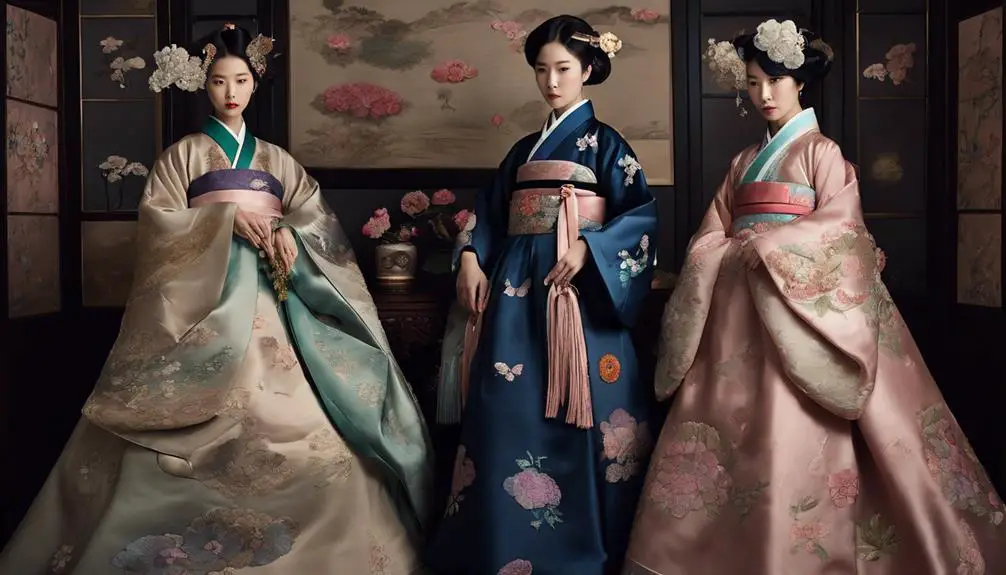
Costume design in *The Handmaiden* not only enhances the visual appeal but also serves as an essential narrative device. Under the creative vision of director Park Chan-wook and costume designer Jo Sang-gyeong, the film's attire elegantly reflects the historical period of the 1910s to 1930s. You'll notice a fascinating blend of traditional Korean hanbok and Western clothing, which beautifully illustrates the characters' social statuses and cultural influences, especially as they navigate a world under Japanese occupation.
Each outfit is meticulously crafted to signify character development. For instance, Hideko's formal kimono acts as a powerful symbol of her transformation and emotional state throughout the film. The color palettes are deliberately chosen, with virginal whites juxtaposed against bold hues, conveying deeper themes of deception and desire. These garments not only enhance the characters' journeys but also reveal their hidden identities, pulling you deeper into the story.
Moreover, the attention to detail in fabrics and accessories gives the film an authentic feel, immersing you in the rich cultural context. As the characters evolve, their costume changes serve as visual indicators of their personal growth and shifting dynamics. You can see how Count Fujiwara's outfits, for instance, reflect his cunning nature and intentions. Overall, the costume design in *The Handmaiden* isn't just about aesthetics; it's an essential element that enriches the storytelling and invites you to explore the intricate layers of the characters' lives.
Key Outfits and Their Significance
In *The Handmaiden*, each key outfit plays an essential role in revealing the characters' inner worlds and changes. The meticulous costume design reflects not just personal style but also profound symbolic meanings that enrich the narrative.
- Hideko's delicate fabrics and virginal shades highlight her sheltered life and innocence.
- The garish reading costume she dons during performances showcases her duality, emphasizing the contrast between her public persona and private desires.
- Sook-hee's change from practical maid attire to more elaborate dresses illustrates her journey from subservience to empowerment.
Take, for example, Hideko's initial white ruffled lace shirt paired with a taupe maxi skirt; these symbolic colors embody purity and restraint, underscoring her constrained existence. As she evolves, her vibrant emerald green silk ball gown marks a pivotal moment of self-discovery and sexual awakening, vividly displaying her newfound identity.
In contrast, Sook-hee's costumes reflect her own growth, evolving alongside her complex relationship with Hideko. The practical fabric choices of her maid attire serve to highlight her initial subjugation, while her later outfits mirror her emerging confidence.
Additionally, the gloves both characters wear symbolize class and social status, but they also represent the concealment of their true selves, hinting at the intimacy they share. Through these key outfits, The Handmaidenmasterfully intertwines fashion with storytelling, using character contrasts and symbolic colors to deepen your understanding of the characters' journeys.
Character Style Transformations
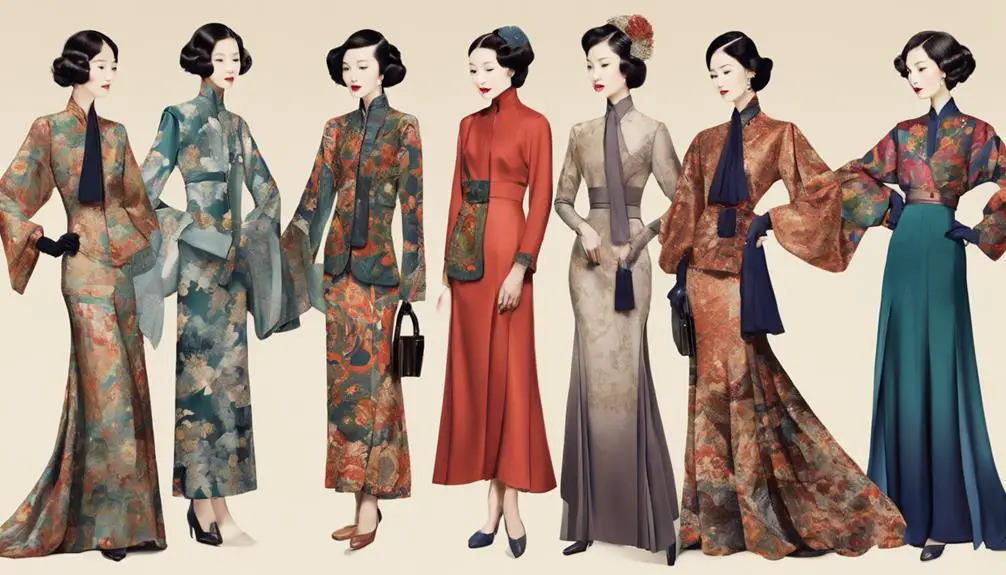
Throughout *The Handmaiden*, characters undergo significant style transformations that visually narrate their emotional and psychological journeys. Hideko's evolution is particularly striking, as her initial wardrobe of delicate fabrics and virginal shades emphasizes her sheltered upbringing and fragility. This softness in her attire cleverly symbolizes her innocence. However, as the narrative unfolds, her outfits grow bolder, reflecting her awakening desires and emerging self-empowerment. From the garish reading costume to the stunning emerald green silk ball gown, each change marks a pivotal moment in her journey, challenging the "poor little rich girl" stereotype.
On the other hand, Sook-hee's practicality shines through her earthy, layered garments, showcasing her resourcefulness within the confines of an oppressive society. Her style is not just functional; it embodies her adaptability and strength as a character. The contrast between Hideko's evolving elegance and Sook-hee's grounded practicality creates a dynamic visual narrative that underscores their respective journeys.
Costume symbolism plays a vital role throughout the film, with each outfit signifying significant plot developments and shifts in character dynamics. These transformations are not mere aesthetic choices; they serve as visual cues that enhance the storytelling. As you observe these characters, you'll notice how their clothing reflects their internal struggles and triumphs, making their journeys all the more enthralling. In *The Handmaiden*, fashion becomes a powerful tool for storytelling, allowing us to dive deeper into the emotional landscapes of Hideko and Sook-hee.
Cultural Influences in Fashion
How do cultural influences shape the fashion seen in *The Handmaiden*? The film's costumes showcase a fascinating blend of traditional Korean hanbok and Western fashion elements, reflecting the complex cultural tensions during Korea's Japanese occupation in the early 20th century. This interplay not only honors traditional aesthetics but also critiques colonial interpretations of identity and expression through clothing, making it a pivotal aspect of the narrative. As seen in the evolution of brands like Abercrombie & Fitch, the adaptation to cultural influences can notably impact the perception of identity through fashion, showcasing the importance of understanding historical contexts in clothing design the evolution of branding.
Consider these key influences:
- Traditional Aesthetics: The hanbok's flowing lines and vibrant colors represent Korea's rich heritage, showcasing the beauty of its culture.
- Colonial Interpretations: The incorporation of Western styles in Hideko's outfits highlights the struggle between maintaining cultural identity and adapting to foreign influences.
- Gender Representation: As Hideko's wardrobe evolves from virginal designs to bold ensembles, it symbolizes her journey toward self-empowerment, reflecting broader themes of gender and autonomy within the film.
The intricate details and luxurious fabrics used in the costumes not only elevate the film's visual appeal but also underscore the social status and emotional states of the characters. Each outfit serves as a narrative device, linking fashion with the characters' experiences and the historical context they inhabit. By intertwining these elements, *The Handmaiden* sparks essential conversations about gender, identity, and cultural representation in fashion, making it a notable contribution to Asian cinema and a visual feast for audiences.
Impact on Contemporary Fashion Trends
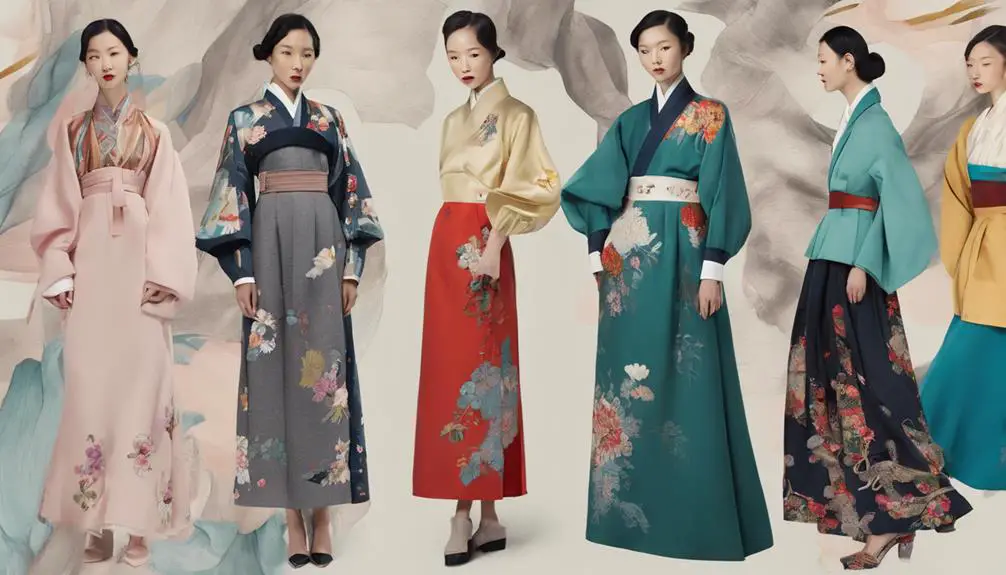
The intricate fashion choices in *The Handmaiden* have sparked a renewed interest in vintage aesthetics within contemporary fashion. You might notice how the film's elegant silhouettes and rich textures breathe life into today's wardrobes. Designers are embracing a vintage revival, channeling the sophisticated style of Hideko's costumes, especially her stunning emerald green silk gown. This bold color palette not only adds a fresh spin but also emphasizes emotional hues that reflect deeper character narratives, making your outfits resonate on a personal level. Additionally, the appeal of vintage items has intensified, as many consumers seek authenticity and quality in their fashion choices, reminiscent of vintage Ralph Lauren characteristics.
As you explore fashion today, you'll see a surge in hybrid styles that elegantly blend traditional Korean hanbok elements with Western attire, celebrating cultural fusion and identity. The revival of accessories, especially gloves, also signals a trend toward vintage-inspired pieces that exude sophistication and class. Wearing these accessories not only enhances your outfit but also connects you to a rich fashion history.
Moreover, Hideko's transformation through her wardrobe sparks conversations about narrative empowerment. Clothing becomes a powerful tool for personal growth, encouraging you to express your identity through what you wear. This shift has led to an increase in narrative-driven fashion showcases, where designers focus on storytelling through their collections. By embracing these trends, you can not only elevate your style but also engage in the broader cultural dialogue that *The Handmaiden* has inspired. So, immerse yourself in this vibrant world of fashion, and let your wardrobe tell your unique story!
Frequently Asked Questions
Is the Handmaiden Movie Lgbtq?
Yes, "The Handmaiden" showcases LGBTQ+ themes through its nuanced queer representation. It explores love dynamics within a complex cultural context, challenging societal norms and highlighting the emotional depth of relationships between the female characters.
Why Do They Speak Japanese in the Handmaiden?
They speak Japanese in "The Handmaiden" to reflect the cultural context and character motivations during Korea's occupation. This choice highlights the historical significance of power dynamics and cultural assimilation faced by Koreans during that era.
Who Is the Lady in the Handmaiden?
In "The Handmaiden," Lady Hideko's character motivations reveal her struggle against oppression. Her evolving costumes symbolize her transformation, reflecting cultural influences and her journey towards empowerment, challenging perceptions of femininity and societal expectations throughout the narrative.
What Is the Meaning of the Handmaiden Movie?
The Handmaiden's meaning lies in its intricate narrative structure, showcasing cultural influences and character symbolism. You'll see how love intertwines with betrayal, challenging traditional gender roles and revealing deeper truths about identity and agency.
